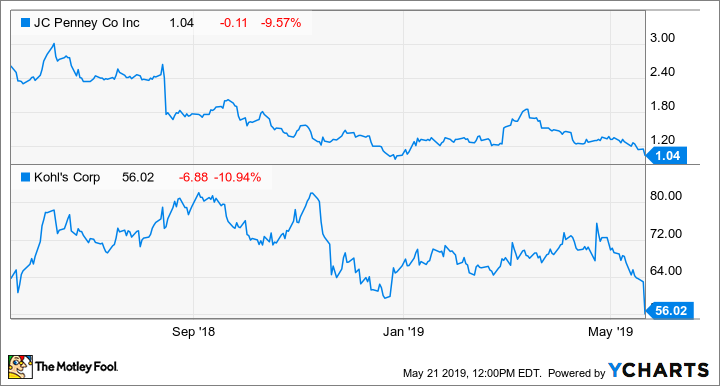Last year was a comeback year for many big department store chains, led by Kohl's (KSS +0.84%), which posted a solid 1.7% comp sales increase and a 34% surge in adjusted earnings per share. J.C. Penney (JCP +0.00%) was one of the few chains that didn't achieve sales and earnings growth last year.
Unfortunately, fiscal 2019 has started on a bad note for these two midprice department store chains. J.C. Penney and Kohl's both reported weak sales and earnings results for the first quarter on Tuesday morning. That sent both stocks crashing to near their 52-week lows.
J.C. Penney and Kohl's stock performance. Data by YCharts.
J.C. Penney continues to stumble
It was a foregone conclusion that J.C. Penney would report falling sales and earnings for the first quarter. Not surprisingly, comparable store sales slid 5.5%, while total revenue fell 4.3% to $2.56 billion.
Gross margin slipped to 33.2% from 33.7% a year earlier, largely due to inventory liquidation related to J.C. Penney's strategic moves to exit the major appliance category, stop selling furniture in its stores, and reduce inventory of slow-selling items. Meanwhile, J.C. Penney's selling, general, and administrative (SG&A) expenses rose by $30 million (3.6% year over year), due to one-time expense offsets having been booked in the first quarter of fiscal 2018.
One bright spot was credit income, which surged 33% year over year to $116 million, offsetting some of the weakness in J.C. Penney's core business. Nevertheless, J.C. Penney's adjusted loss more than doubled to $0.46 per share from $0.22 per share a year ago. This result also missed the analyst consensus, which called for an adjusted loss of $0.38 per share.

J.C. Penney posted another big loss last quarter. Image source: J.C. Penney.
The other piece of good news from the earnings report was that J.C. Penney reduced its Q1 cash burn to $268 million from $421 million a year ago. That keeps the company on track to meet its goal of delivering positive free cash flow on a full-year basis.
J.C. Penney also announced another key executive hire on Tuesday. Shawn Gensch, who spent a decade at Target from 2003 to 2013 -- finishing as SVP of marketing -- will join the company as chief customer officer early next month.
Kohl's momentum runs out
Back in early March, Kohl's management warned that the first fiscal quarter had gotten off to a slow start in February. As a result, CFO Bruce Besanko projected that comparable-store sales would be roughly flat for the quarter.
The reality was far worse. Comp sales fell 3.4% last quarter, ending a six-quarter streak of positive comps. Total revenue declined 2.9% to $4.09 billion. Management blamed cool, wet weather as a key driver of the sales decrease.

Kohl's reported an unexpected sales decline in the first quarter. Image source: Kohl's.
Kohl's gross margin ticked down to 36.8% last quarter from 36.9% in the prior-year period, while SG&A expenses rose 1.2%. That caused adjusted net income to decline about 8% year over year, reaching $98 million. Adjusted EPS slipped to $0.61 from $0.64 a year ago, falling short of the average analyst estimate of $0.67.
Good expense management enabled Kohl's to blunt the impact of weak sales on its profitability, but the company still slashed its full-year earnings guidance. Kohl's now expects adjusted EPS between $5.15 and $5.45, far below the prior range of $5.80 to $6.15.
More questions than answers
Both department store giants' earnings reports likely left investors with more questions than answers. J.C. Penney CEO Jill Soltau still hasn't presented a full turnaround strategy for the struggling company. Until she does, it will remain hard to assess the likelihood that J.C. Penney can reinvent itself to salvage any value for shareholders.
As for Kohl's, investors are left to wonder whether the unexpected sales slump last quarter was a fluke or the beginning of a new trend. Kohl's has lots of initiatives in the pipeline to boost sales, including subdividing its stores to make room for complementary high-traffic tenants, accepting returns for Amazon.com, and introducing new brands to its assortment. But all these efforts could fail if Kohl's stores themselves are losing relevance with customers.
It's certainly true that retailers faced significant headwinds last quarter, ranging from delayed tax refund checks to unusual weather patterns. However, J.C. Penney and Kohl's now face pressure to show meaningful signs of improvement when they report their second-quarter earnings results three months from now.







